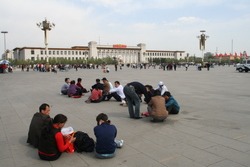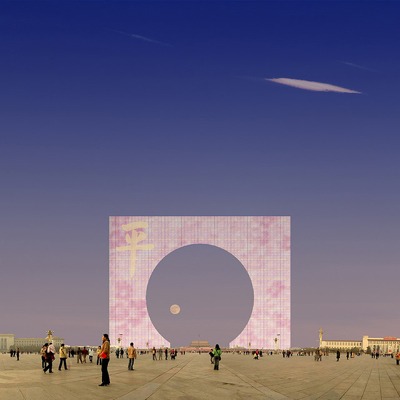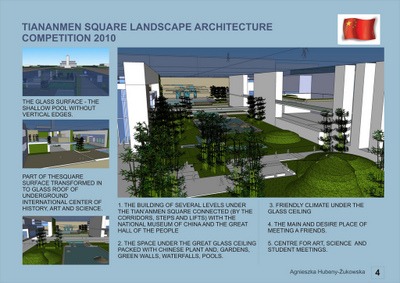
An international Web 2.0 design competition for Tiananmen Square was announced in March 2009. The winners are listed below. A full .pdf report on the Tiananmen competition is available for free download from the Gardenvisit.com Website. All the Tiananmen entries can be seen on Flickr. The 3 judges, listed below, thank everyone who took part.
• Christine Storry (Australia): architect and urban designer
• Tom Turner (UK): landscape architect and town planner
• Xiru Zhao (China): architect
First prize: Thunsdorff
Thunsdorff, Ueli Mueller Landscape Design, Kleinertstrasse 3, 8037 Zurich, Switzerland, mail @ uelimueller.ch, www.uelimueller.ch
The Thunsdorff design is visually strong, deceptively simple and a complex response to the site. A Moon Gate has historic, symbolic and garden interest. The people’s encyclopedia (Wikipedia) states that:
A Moon Gate (Chinese: 月亮门; pinyin: yuèliàng mén) is a circular opening in a garden wall that acts as a pedestrian passageway, and a traditional architectural element in Chinese gardens. Moon Gates have many different spiritual meanings for every piece of tile on the gate and on the shape of it. The sloping roofs of the gate represent the half moon of the Chinese Summers and the tips of the tiles of the roof have talisman on the ends of them…. The purpose of these gates is to serve as a very inviting entrance into gardens of the rich upper class in China. The gates were originally only found in the gardens of wealthy Chinese nobles.
The Chinese word for round (圆,yuan) has the same pronunciation as the Chinese word for ‘garden’ (园,yuan). Another meaning of ‘yuan’ in Chinese is ‘perfect’ (圆满)- which is a symbol representing the owner of a garden who wishes to conduct himself perfectly and work smoothly. The placement of the Moon Gate in Tiananmen Square creates two spaces with a pedestrian link and, alluding to them as two different gardens. There could be problems for traffic on Changan Street and obstruction of the visual axis from the Tiananmen Gate. A vehicular underpass would also be possible. The great Moon Gate can symbolise the ancient desire for Harmony and Unity – and the fact that modern China belongs to all of its people and no longer to a rich upper class. Thunsdorff explains the design in thirty words:
China – Country of grand spirit -The world’s largest square shall remain an open space – We suggest a new perspective link between past and present pointing to the future – Heavenly Peace
There may be something of Confucius in this (‘Study the past if you would define the future’) and also something of Chairman Mao (‘Such is history, such is the history of civilization for thousands of years’). The idea of a sublime symbol soaring above the commercialism of modern Beijing is attractive, with something of a parallel in the Parisian Grande Arche. The comparison between the Ming dynasty axis in Beijing and the Louvre-Defense axis in Paris is interesting – and both can be carried into the future as examples of how city form can be conserved and extended. They support the view that 600 years is a good timescale for city planning: one should look back at least 300 years and look forward at least for another 300 years.
Second Prize Aga H
Aga H Agnieszka Hubeny-Zukowska, Pracownia Sztuki Ogrodowej, 80-360 Gdańsk Ul.Krzywoustego 5A/5, Poland, Tel./fax: +48 (58) 511-04-69 www.pracowniasztukiogrodowej.pl biuro [@] pracowniasztukiogrodowej.pl
The Aga H design proposes a context-sensitive underground design which retains the integrity of Tiananmen Square as a huge and yet balanced space. The underground ‘garden world’ also responds to the context of a climate which is too hot in summer and too cold in winter. Aga H sees great value in traditional Chinese design but, as a world city, argues that Beijing can also symbolise a modern approach to design. To leave space for great events and to avoid competition with older buildings, the surface level therefore remains ’empty’. At ground level the main change would be two great blocks of pleached trees with seating beneath. They would flank the Monument to the People’s Heroes and the Mausoleum of Mao Zedong. A glass-roofed space beneath Tiananmen Square would contain a garden world and a Center for History, Art and Science. There would be underground links to the National Museum of China and the Great Hall of the People.
Third Prize: Whitney Hedges
Whitney Hedges, garden designer and landscape architect, England, www.whitneyhedges.co.uk polkadotplants @ googlemail.com
Only eighteen words of explanation were given (‘One Light: Strong lights projecting upwards, set flush into paving. Commemorating those who fell in the 1989 demonstrations’) but more points arose in an online discussion: ‘I like Whitney Hedges design very much… it is sensitive to all the considerations for this site and yet is quite a dramatic statement of the individuals heroic messages’. ‘One could also say that it links Earth to Heaven, which was the traditional role of Chinese Emperors (they were Sons of Heaven)’. ‘ I’m not sure that mixing these images of the Speer’s “Cathedral of Light” at the Nuremberg Rally with the image of the Tiananmen Square is a very good idea’. The reference to Speer is both interesting and troubling.




Great!
The moon gate has a very strong vision strength and it finds a simple way to show Chinese Cuture. It could have another wonderful meaning that :The unity of China. Also, it could say something about Feng Shui(http://www.gardenvisit.com/history_theory/garden_landscape_design_articles/design_methods/feng_shui)
For example, this moon gate could change the whole axis, make it more dynamic and – bring luck to Chinese people.
But I am wondering whether it is a little bit symbolic and it there should be more thinking about the scale of the square. As everyone knows, Tianmen Square was not designed by landscape architect and was not designed in a “human scale”. It is said that Tianmen Square was designed for parking the airplane which was considered by Chairman Maohttp://news.ifeng.com/history/1/200707/0720_335_160441_1.shtml
It may good for military use, but it is not good for the users, for example, there are no trees and the sculptures are too high. Therefore, I would like to know if the moongate designer thought of this? Except this great cultural meaning of the moongate, is there any other consider of it?
I agree with your comments and would like to know the answers to your questions.
With regard to your last question, I believe the Moon Gate idea could coexist with other changes to Tiananmen Square. I like the idea that the Moon Gate would give a cultural symbol the kind of dominant skyline role which the Eifel Tower has in Paris (which can be thought of as ‘Bejing’s western cousin’). European cities were dominated by cathedrals in former times and it would be a pity if all cities were to be dominated by commercial symbols.
I think so, if the cities are dominated by commercial symbols it will be a shame.
Back to the Moon Gate design of Tiananmen Square, I think that it can be judged in two satages:
(1)Take it as Garden deaign Stage
Tian’anmen Square is 500m*880m and It has a main axis from The Tian’anmen Rostrum. Then the Moon Gate could become a landscape node and a smbol of the axis,but the thing is that Tian’an men Square probably donot need a symbol in the future.Because The Monument to the people’s Heroes was the symbol there.If the moon gate will be a temporary landscape symbol ,it will be great, especially for Chiese National Day,Chinese new year,act.Because it have a wonderful meaning in Chinese culture and the use the enframed scenery design method is also suit for Chinese Traditional Garden Design. Therefore, I admire that the designer( Western designder) can know Chinese culture and garden design art.
(2)Take it as Landscape Architecture Stage
If we think Tian’anmen Square as Landscape design. I am afraid that it may think how this new design will solve the problems. For example, how to satisfy the tourisms need and escape them form the blazingsun,torrential rain at least.I have been there many times and I donot like it because there is no space for me except the memory of the heros who built the our China.Additionally,how such a big square contribute to Climate change? Is there any possible to create the microclimate here and make some benefit for the traffic jam happened there every day.
Old Beijing must have been symbolically dominated by the Forbidden City. It could have been a symbol of harmony in Ming times and of oppression in Qing times.
A monument to the People’s Heroes is an attractive subject for a symbol but it can never have had a role on the Beijing skyline. Also, harmony is a better subject for a symbol than heorism. Harmony is rooted in Chinese culture and I can’t think of any large country which has as good a claim as China to having stood for peace and harmony through the millennia. North, Central and West Asian countries have been far more aggressive (though I attribute this more to horse-culture vs. rice-culture than to the innate goodness of the Chinese people).
I agree that the Moon Gate makes no contribution to dealing with either climate change or Beijing’s often-unfriendly climate, and also that it could ‘start life’ as a temporary feature for the Chinese New Year.
I am happy that you like Chinese peace and harmony culture.Yes!
You always understand my country much more deeper than me and never mind my naive. I totally admire!
Also, I think this web 2.0 landscape design competition is really interesting!
I know next to nothing about China, compared to you, but an outsider can often have a different viewpoint – and so does someone who has lived outside their own country. Rudyard Kipling wrote:
Winds of the World, give answer! They are whimpering to and fro
And what should they know of England who only England know?
And he could have asked: what should they know of China who only China know?
Thank you so much for your vivid explaination. I see now.
It is worth considering how the site may have been thought of in the past.
[ http://en.wikipedia.org/wiki/File:Verbotene-Stadt1500.jpg ]
ps. Poppy can you tell me if the pole star visible in the night sky from Tiananmen Square?
Re Christine,this is a very interesting,unfortunately I could not find the answer in Books. I just can say:I never note it.:(
Poppy you could possibly begin to find out about the importance of the pole star to Chinese culture by visiting the British Museum.
[ http://www.britishmuseum.org/explore/highlights/highlight_objects/asia/t/talisman_of_the_pole_star,_ink.aspx ]
Let me know what you find out!
Many thanks for a great competition!!!
I would like to thanks all great architects, landscape architects and designers for a wonderful competition full of interesting ideas. For me it was a great opportunity to learn how one place can be seen by different peoples, how many ideas can be given for one place!! So many graphic techniques in one place is also very interesting.
I’m waiting for a new competition 🙂
A further element monumental. A missed opportunity to go beyond praise … a draft anti-monumental. They needed a functional place for freedom and fragility!
enrico nieri studio architecture research, the project most brilliant and beautiful!
disappointment that the beauty and fragility will save the world!